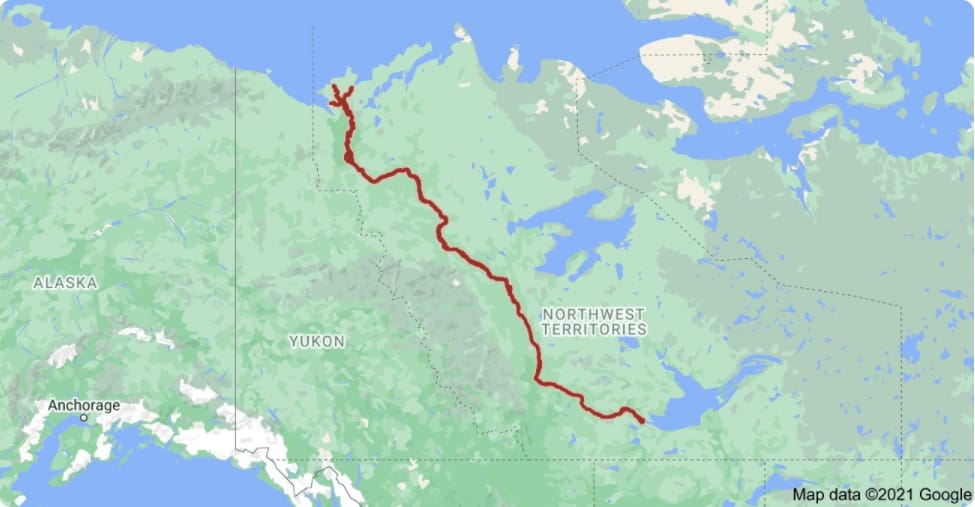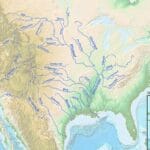Get ready for an exciting journey into the vibrant watery world of Canada. We’re diving into the heart of its majestic rivers, like the enormous Mackenzie, the famous St. Lawrence, and the untamed Yukon. Along this adventure, we’ll uncover the hidden secrets of these water giants, meet the creatures that call them home, and learn how they’ve shaped Canada’s landscape and heritage. So, buckle up and let’s navigate the currents together!
Main Rivers in Canada
Canada, with its breathtaking landscapes, is a land interwoven with a network of rivers. These rivers are more than just lines on a map; they’re like the veins of the country, pulsing with life and history. Canada boasts an impressive 47 rivers that stretch for over 600 kilometers—that’s longer than a drive across most countries! Let’s dive into the stories of some of these mighty Canadian rivers.
The Mackenzie: King of the North
Imagine a river so long it could stretch across the entire United States! That’s the Mackenzie River, the undisputed king of Canadian waterways. This giant begins its journey high up in the Rocky Mountains, winding its way northeast for a whopping 4,240 kilometers (2,635 miles) before finally meeting the icy waters of the Arctic Ocean. To put that in perspective, the Mackenzie River is Canada’s longest river and the tenth-longest globally!
The Mackenzie isn’t just about size, though. The basin it carves out is like a world of its own, teeming with diverse wildlife and home to indigenous communities who have relied on its waters for generations.
Want to discover more about the awe-inspiring Mackenzie River? Explore the longest rivers in Canada and delve into their remarkable lengths and features!
The Saint Lawrence: A Liquid Highway
Connecting the vast Great Lakes to the Atlantic Ocean, the St. Lawrence River is like a busy highway for ships and boats. At 3,057 kilometers (1,900 miles) long, this iconic waterway carries goods from the heart of North America to ports around the globe. But the St. Lawrence isn’t just about industry. The valley it flows through is famous for its fertile farmlands and picture-perfect scenery, attracting visitors from all over.
The Nelson: A Powerful Force
Flowing into the vast Hudson Bay, the Nelson River, at 2,574 kilometers (1,600 miles), is another heavyweight of the Canadian river system. This river is a force of nature, and people have learned to harness its powerful currents to generate hydroelectricity, powering homes and businesses across the region. But the Nelson is also a vital part of the ecosystem, supporting a rich diversity of fish and other aquatic life.
More Than Just Water
What’s amazing about these rivers, and many others across Canada, is that they’re much more than just water flowing downhill. They’re vital to the environment, providing homes to a dazzling array of creatures, from tiny fish you can hold in your hand to massive whales that dwarf even the largest boats.
And of course, people depend on these rivers too. We use their water for everything from growing our food to running our factories. And let’s not forget about transportation: rivers have always been a way to connect communities and move goods, and that’s still true today in many parts of Canada.
Which River is the Longest in Canada?
So, we’ve been talking about some impressive rivers in Canada, but which one takes the crown for being the absolute longest? Well, that honor goes to the mighty Mackenzie River!
Now, you might be thinking, “Hold on, what about the St. Lawrence River? It’s famous!” And you’d be right, the St. Lawrence is a big deal, especially when it comes to how much water it carries – it actually surpasses the Mackenzie in that department. But when we’re talking sheer length, the Mackenzie reigns supreme.
Think about it: this river winds its way through five Canadian provinces and territories, acting like a giant connecting thread across the country. Along the way, it carves out stunning landscapes, provides a home for tons of wildlife, and plays a vital role in the lives of the people who live near its banks.
Experts believe the Mackenzie River ranks among the top 12 longest river systems in the world – pretty impressive, right? But beyond its size, it’s the sheer diversity of the regions it flows through that makes it so special. From the rugged mountains to the vast boreal forests, the Mackenzie River is a testament to the beauty and complexity of Canada’s natural environment.
Eager to delve deeper into the grandeur of North America’s waterways? Immerse yourself in the stories of the 5 biggest rivers in the US, each with its own captivating history and significance.
Exploring the Mighty Mackenzie: A Journey Down Canada’s Longest River
Imagine a river so massive it could swallow entire countries. That’s the Mackenzie River, Canada’s undisputed king of waterways! We’ve already dipped our toes into its story, but there’s so much more to uncover.
The Mackenzie River’s Grand Scale
This river isn’t just long – it’s ludicrously long. Stretching over 1,738 miles, the Mackenzie flows from the heart of the Rocky Mountains all the way to the icy grip of the Arctic Ocean. And we’re not just talking about a skinny stream here. The Mackenzie boasts a basin that sprawls over a mind-boggling 700,000 square miles. To put that in perspective, that’s larger than the entire state of Alaska! This river is a true giant, a testament to the raw power and scale of Canada’s wilderness.
A Tapestry of Life
But the Mackenzie isn’t just about size; it’s teeming with life. Beneath its surface, a vibrant aquatic world unfolds. Schools of Arctic grayling dart through the currents, while hefty northern pike and walleye lurk in the depths, waiting to ambush their prey.
And it’s not just the fish that call this river home. Along the Mackenzie’s banks, a rich tapestry of riparian habitats provides a haven for a stunning array of wildlife. You might catch a glimpse of a majestic grizzly bear lumbering through the undergrowth, its massive paws leaving tracks in the soft earth. Or perhaps you’ll hear the haunting howl of a wolf pack echoing through the trees, a spine-tingling reminder of the wildness that still thrives here. And as the seasons change, the Mackenzie becomes a crucial stopover point for countless migratory waterfowl, their journeys spanning thousands of miles.
A Vital Artery
For centuries, the Mackenzie has been more than just a river – it’s a lifeline. Indigenous communities have lived along its banks for generations, their cultures deeply intertwined with its rhythms. The Mackenzie provides sustenance, its waters teeming with fish that have fed families for countless generations. It’s a source of spiritual connection, its very presence a reminder of the delicate balance between humanity and nature.
But the river’s importance extends beyond these communities. Industries have come to rely on the Mackenzie as a vital artery for transportation, moving goods and resources across vast distances. It’s a testament to the river’s economic significance, a powerful engine driving growth and connecting remote corners of the country.
Threats to the River’s Health
But even giants face threats. Climate change, that looming specter, casts a long shadow over the Mackenzie. Melting glaciers and thawing permafrost, driven by rising temperatures, are causing unprecedented changes. Water levels are reaching record lows, disrupting the delicate balance of the river’s ecosystem. Fish populations are feeling the pressure, their habitats shrinking, and the timing of their migrations thrown into disarray. Wildlife, too, is facing the consequences, their food sources dwindling, and their traditional ranges shifting. And for the communities that depend on the Mackenzie, the future is uncertain. Their livelihoods are intertwined with the river’s health, and the changes it’s undergoing pose profound challenges.
It’s not just climate change that threatens the Mackenzie. Industrial activities, while vital to the economy, also pose risks. Pollution from mines and factories can contaminate the water, harming wildlife and putting human health at risk. Dams, built to harness the river’s energy, can alter its flow, disrupting fish migration patterns and impacting downstream ecosystems. The challenge lies in finding a sustainable path forward, one that balances economic development with the need to protect this precious resource for generations to come.
Key Takeaways:
- The Mackenzie River, Canada’s undisputed champion of rivers, stretches over 1,738 miles, dwarfing most other waterways on the continent.
- The river is a biodiversity hotspot, supporting a remarkable variety of fish, wildlife, and plant life, a testament to the complexity of nature.
- For indigenous communities, the Mackenzie is more than just a river; it’s a source of life, culture, and spirituality, a connection to their ancestral past.
- Climate change and industrial activities are putting increasing pressure on the Mackenzie, highlighting the urgent need for sustainable practices and conservation efforts.
What are the Top 5 Longest Rivers in Canada?
Ready to dive into the top 5 longest rivers in Canada? Let’s go!
- Mackenzie River: Let’s kick things off with the king of the rivers – the mighty Mackenzie. This giant cuts through the heart of Canada, flowing a jaw-dropping 2,635 miles. It starts way up in the Rocky Mountains and eventually empties into the icy waters of the Beaufort Sea. Just imagine the stories this river could tell!
- Fraser River: Next up, we’re heading over to beautiful British Columbia, home to the Fraser River. This 854-mile-long beauty winds its way through some of the most picturesque landscapes you can imagine, eventually joining the Pacific Ocean near Vancouver. It’s a vital part of the province’s identity, supporting everything from salmon runs to thriving communities.
- Columbia River: Sticking with British Columbia for a moment, we’ve got another contender for the most scenic river – the Columbia River. This one clocks in at a respectable 1,243 miles, connecting the majestic Canadian Rockies to the Pacific Ocean. It’s a powerful force of nature, carving out canyons and providing essential resources for people and wildlife alike.
- Athabasca River: Now, let’s hop over to Alberta, where the Athabasca River takes center stage. At 956 miles long, it’s a vital waterway for the province, supporting a rich diversity of life. The Athabasca eventually joins forces with – you guessed it – the mighty Mackenzie River system, adding its own unique character to this incredible network of waterways.
- Peace River: Last but certainly not least, we have the Peace River, another stunning waterway that flows through both British Columbia and Alberta. Spanning 1,195 miles, it originates high up in the Rocky Mountains and eventually joins the Slave River (which, you guessed it again, is part of the Mackenzie River system!). Talk about one interconnected water world!
Key Takeaways:
- Canada is a land of rivers! We have a ton of them, and many are seriously long.
- The Mackenzie River is the undisputed champ, stretching over 2,600 miles.
- British Columbia’s Fraser and Columbia rivers are both vital waterways, shaping the province’s landscape and economy.
- Alberta’s Athabasca River is a biodiversity hotspot and eventually flows into (you guessed it) the Mackenzie River.
- The Peace River winds through breathtaking landscapes in BC and Alberta before joining the vast Mackenzie River system.
Want to uncover the secrets of the longest lake in the US and marvel at its breathtaking expanse?
















